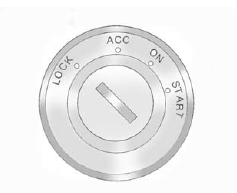Chevrolet Captiva Owners Manual: Ignition Positions

The ignition switch has four different positions.
To shift out of P (Park), turn the ignition to ON/RUN or ACC/ ACCESSORY and apply the regular brake pedal.
Caution
Using a tool to force the key to turn in the ignition could cause damage to the switch or break the key. Use the correct key, make sure it is all the way in, and turn it only with your hand. If the key cannot be turned by hand, see your dealer.
LOCK (STOPPING THE ENGINE/ LOCK/OFF): When the vehicle is stopped, turn the ignition switch to LOCK/OFF to turn the engine off.
Retained Accessory Power (RAP) will remain active. See Retained Accessory Power (RAP) on page 9-18.
This position locks the ignition.
It also locks the steering wheel and the transmission. The key can only be removed in LOCK/OFF. The shift lever must be in P (Park) to turn the ignition switch to LOCK/OFF.
The steering can bind with the wheels turned off center. If this happens, move the steering wheel from right to left while turning the key to ACC/ACCESSORY. If this does not work, the vehicle needs service.
Do not turn the engine off when the vehicle is moving. This will cause a loss of power assist in the brake and steering systems and disable the airbags.
If the vehicle must be shut off in an emergency:
- Brake using a firm and steady pressure. Do not pump the brakes repeatedly. This may deplete power assist, requiring increased brake pedal force.
- Shift the vehicle to N (Neutral).
This can be done while the vehicle is moving. After shifting to N (Neutral), firmly apply the brakes and steer the vehicle to a safe location.
- Come to a complete stop, shift to P (Park), and turn the ignition to LOCK/OFF. On vehicles with an automatic transmission, the shift lever must be in P (Park) to turn the ignition switch to the LOCK/OFF position.
- Set the parking brake. See Parking Brake on page 9-26
Warning
Turning off the vehicle while moving may cause loss of power assist in the brake and steering systems and disable the airbags.
While driving, only shut the vehicle off in an emergency.
If the vehicle cannot be pulled over, and must be shut off while driving, turn the ignition to ACC/ ACCESSORY.
ACC (ACC/ACCESSORY): This is the position in which you can operate some electrical accessories or items plugged into the accessory power outlets.
Use this position if the vehicle must be pushed or towed.
ON (ON/RUN): This position can be used to operate the electrical accessories and to display some instrument cluster warning and indicator lights. This position can also be used for service and diagnostics, and to verify the proper operation of the malfunction indicator lamp as may be required for emission inspection purposes.
The switch stays in this position when the engine is running. The transmission is also unlocked in this position. If you leave the key in the ACC/ACCESSORY or ON/RUN positions with the engine off, the battery could be drained. You may not be able to start the vehicle if the battery is allowed to drain for an extended period of time.
START: This is the position that starts the engine. When the engine starts, release the key. The ignition switch returns to ON/RUN for driving.
A warning tone will sound when the driver door is opened, the ignition is in ACC/ACCESSORY or LOCK/ OFF, and the key is in the ignition.
Chevrolet Captiva's ignition switch features four distinct positions, each designed to manage the vehicle's electrical systems and engine operation effectively. The first position, Lock/Off, is the farthest counterclockwise setting, locking the steering wheel and shutting off all electrical systems. This position is crucial for vehicle security, as the key can only be inserted and removed here, ensuring the car is securely parked and protected from theft.
The second position is ACC (Accessory), which allows the use of certain electrical systems such as the radio and power windows without starting the engine. This is particularly useful when you need to use these features while the engine is off. The third position, On/Run, activates all of the vehicle's electrical systems and illuminates the dashboard indicators. This position readies the vehicle for start-up and is also used to check the functionality of warning lights. Finally, the Start position engages the starter motor to crank the engine. Once the engine starts, releasing the key returns it to the On/Run position, allowing the engine to continue running and keeping all electrical systems active.
Understanding these ignition positions is essential for the proper operation of the 2006-2018 Chevrolet Captiva. Each position serves a specific function, from securing the vehicle and using electrical accessories to starting and running the engine, ensuring a smooth and efficient driving experience.
 New Vehicle Break-In
New Vehicle Break-In
Caution
The vehicle does not need an
elaborate break-in. But it will
perform better in the long run if
you follow these guidelines:
Do not drive at any one
constant speed, fast or slow,
fo ...
 Starting the Engine
Starting the Engine
Move the shift lever to P (Park) or
N (Neutral). The engine will not start
in any other position. To restart the
engine when the vehicle is already
moving, use N (Neutral) only.
Caution
Do no ...
More about:
Chevrolet Captiva Service & Repair Manual > Interior Panels: Window Regulator
Front
1.
Remove front door trim panel as outlined
under "Door Trim Panel."
2.
Remove front door water deflector.
3.
Remove front door window regulator
nuts, Fig. 1.
4. ...
Chevrolet Captiva Owners Manual
- Introduction
- In Brief
- Keys, Doors, and Windows
- Seats and Restraints
- Storage
- Instruments and Controls
- Lighting
- Infotainment System
- Climate Controls
- Driving and Operating
- Vehicle Care
- Service and Maintenance
- Technical Data
- OnStar
